Book contents
- Frontmatter
- Contents
- List of tables and figures
- Foreword by the HONORABLE RICHARD A. POSNER
- Preface
- Part I The role of credit
- Part II Bankruptcy as a reflection of the creditors' implicit bargain
- Part III Beyond the basic creditors' bargain
- Part IV Workouts or bargaining in the shadow of bankruptcy
- Part V Alternatives to bankruptcy and the creditors' bargain
- Part VI Experience of other countries
- Index
Part III - Beyond the basic creditors' bargain
Published online by Cambridge University Press: 10 December 2009
- Frontmatter
- Contents
- List of tables and figures
- Foreword by the HONORABLE RICHARD A. POSNER
- Preface
- Part I The role of credit
- Part II Bankruptcy as a reflection of the creditors' implicit bargain
- Part III Beyond the basic creditors' bargain
- Part IV Workouts or bargaining in the shadow of bankruptcy
- Part V Alternatives to bankruptcy and the creditors' bargain
- Part VI Experience of other countries
- Index
Summary
Nothing in the basic creditors' bargain heuristic requires that bankruptcy law alter the contractual priorities among claimants to a firm's assets. Indeed several of the chapters included in Part II explore how bankruptcy law can provide a collective proceeding while honoring contractual priorities. Yet bankruptcy's collective process routinely breaches contractual – or “absolute” priority – in that bankrupt firms distribute assets to equity interests though the firms are insolvent and distribute assets to general, low-priority creditors without fully satisfying high-priority claims. These breaches in absolute priority are partly a direct consequence of rules that favor redistribution, and largely a consequence of bankruptcy's expensive negotiation procedures, which induce high-priority claimants to make concessions in return for settlement and termination of the costly process. The chapters in this part explore in more detail how the bankruptcy process alters contractual priorities.
The first chapter is Douglas G. Baird and Thomas H. Jackson, “Bargaining after the fall and the contours of the absolute priority rule.” In this chapter, Baird and Jackson explore the bankruptcy negotiation process among highpriority creditors, low-priority creditors, and equity. They note that this negotiation process may produce breaches in absolute priority if one focuses solely on the outcome. But, Baird and Jackson explain, one must be aware of the possibility that the outcome is a product of a hypothetical distribution consistent with absolute priority followed by creditors' concession to equity as consideration for equity's continued participation in the firm.
- Type
- Chapter
- Information
- Corporate BankruptcyEconomic and Legal Perspectives, pp. 109 - 112Publisher: Cambridge University PressPrint publication year: 1996



